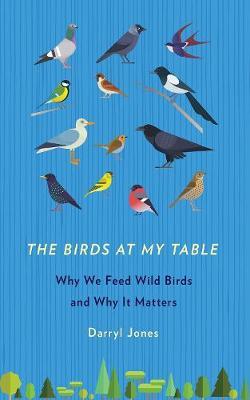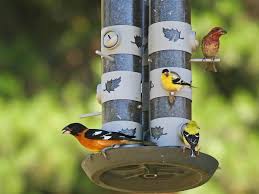by Anne Kilgannon

This is not the usual kind of book on feeding wild birds, with tips on feeder styles and seeds. Author Darryl Jones is a Griffith University Professor and Deputy Director of Environmental Futures Research Institute, in Brisbane, Australia. He asks a lot of hard questions about the how, when, and especially why a growing number of people in many countries feed birds and then he dives into any research that exists to find the answers. He pokes and probes, travels everywhere to meet others in this field or anyone he thinks might have some inklings of the meaning and impact of this practice. He examines his own bird feeding and those of friends and neighbors, casually and in rigorously designed studies. Darryl Jones really wants to know!
He is aware that many—probably most—feeders of birds begin this curious habit without much knowledge of birds or deep thought about the impact of their largesse. Often, he found, people begin feeding birds by scattering bread crumbs, kitchen scraps, or purchased seed because there had been a winter storm or other instance of harsh weather, perhaps a drought. One fascinating tidbit he reveals is the differing cultural choices of what to feed birds: in Australia it is not uncommon to provide large amounts of raw meat, hamburger and sausages, for instance. It turns out many common Australian birds are carnivorous. It is startling to imagine the sight—and smell.
Jones finds that winter feeding is the most widely practiced program and the most accepted. Until recently, it was quite frowned upon to feed birds at any other time. There was a belief, strenuously propagated, that feeding birds during their nesting time would actually be harmful; there was a fear that nestlings would choke on human offerings or die from unbalanced diets. That turned out to be unfounded but it was a deeply felt supposition in many places. There are other cultural beliefs and taboos that still shape this pastime but, as he discovered, very little actual knowledge or sustained scientific research on the topic. Jones had more questions than answers; partial information only led him on to dig deeper and search out more research that would fill in some of the gaping blanks he discovered. This is a relentlessly science-based inspection of a somewhat cavalier human behavior, a fascinating contrast in approaches.

Jones did find more and more people feeding birds in many places. And he did come to some conclusions about how this movement had developed, seemingly spontaneously, if not definitively. More people live in cities and suburbs and are looking for some connection to nature, now tenuous or lost. Feeding birds recreates that contact, that opportunity to see birds close up and to feel you are doing something to help them survive and even thrive. There is an acknowledgement that we’ve paved over and disrupted the birds’ normal places and that we ought to compensate birds for what we’ve destroyed. And, secondly, there is now a growing bird feeding industry happily supplying us with “mass produced, ready-made, packaged mixes” and myriad designed feeders that enable us to indulge this pursuit with ease. So long as we are availing ourselves of quality, fresh, appropriate mixes, this has been a boon, but there is no doubt the industry has both facilitated and helped create this newfound practice.
There isn’t room here to more than hint at Jones’ wide-ranging analysis beyond the obvious. He examines far beyond the choices of black sunflower seeds or nyger—the British name for thistle seed, suet or mealworms, asking what do birds really need and not just what is available in the marketplace, through different life phases and seasons. How does it change bird behavior to habituate them to approach a feeder when other species are present with whom they would not normally interact? Do feeders create disease vectors? How does feeding impact the timing of breeding season and the numbers of surviving offspring? And how do the changing outcomes impact population trends and species survival? And larger still, do these changes—and there were behavioral changes—impact entire ecosystems? What are we doing to the balance of nature? Are birds that are weaker surviving and reproducing, thereby influencing the evolution of species? Are humans really helping or thoughtlessly interfering? More research is needed!
But one thing was certain, that although Jones found that there is much still to be learned about the impact of bird-feeding on birds, and that more research was crucial, it is abundantly clear that feeding birds has the power to change the world because it changes humans. In the Anthropocene*, what humans do, matters. Feeding birds helps us reconnect to nature; it stokes our need to engage, to wonder and to care. It is a chance to address our “extinction of experience” and bring birds and other animals back into our lives. With better science to examine our role and responsibilities, we can feed the birds with more wisdom and cherish our shared moment, especially in this time of bird-watching from our confined home spaces. Darryl Jones has a lot to tell us about this path forward. We are all a part of this global experiment.
*Definition from http://www.anthropocene.info/, a website dedicated to the discussion of this new geological era: “The Anthropocene defines Earth’s most recent geologic time period as being human-influenced, or anthropogenic, based on overwhelming global evidence that atmospheric, geologic, hydrologic, biospheric and other earth system processes are now altered by humans.” The word combines the root “anthropo”, meaning “human” with the root “-cene”, the standard suffix for “epoch” in geologic time.
